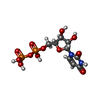+検索条件
-Structure paper
| タイトル | The structure of EXTL3 helps to explain the different roles of bi-domain exostosins in heparan sulfate synthesis. |
|---|---|
| ジャーナル・号・ページ | Nat Commun, Vol. 13, Issue 1, Page 3314, Year 2022 |
| 掲載日 | 2022年6月8日 |
 著者 著者 | L F L Wilson / T Dendooven / S W Hardwick / A Echevarría-Poza / T Tryfona / K B R M Krogh / D Y Chirgadze / B F Luisi / D T Logan / K Mani / P Dupree /     |
| PubMed 要旨 | Heparan sulfate is a highly modified O-linked glycan that performs diverse physiological roles in animal tissues. Though quickly modified, it is initially synthesised as a polysaccharide of ...Heparan sulfate is a highly modified O-linked glycan that performs diverse physiological roles in animal tissues. Though quickly modified, it is initially synthesised as a polysaccharide of alternating β-D-glucuronosyl and N-acetyl-α-D-glucosaminyl residues by exostosins. These enzymes generally possess two glycosyltransferase domains (GT47 and GT64)-each thought to add one type of monosaccharide unit to the backbone. Although previous structures of murine exostosin-like 2 (EXTL2) provide insight into the GT64 domain, the rest of the bi-domain architecture is yet to be characterised; hence, how the two domains co-operate is unknown. Here, we report the structure of human exostosin-like 3 (EXTL3) in apo and UDP-bound forms. We explain the ineffectiveness of EXTL3's GT47 domain to transfer β-D-glucuronosyl units, and we observe that, in general, the bi-domain architecture would preclude a processive mechanism of backbone extension. We therefore propose that heparan sulfate backbone polymerisation occurs by a simple dissociative mechanism. |
 リンク リンク |  Nat Commun / Nat Commun /  PubMed:35676258 / PubMed:35676258 /  PubMed Central PubMed Central |
| 手法 | EM (単粒子) |
| 解像度 | 2.43 - 2.93 Å |
| 構造データ | EMDB-11923, PDB-7au2: EMDB-11926, PDB-7aua: |
| 化合物 |  ChemComp-MN:  ChemComp-UDP: |
| 由来 |
|
 キーワード キーワード | TRANSFERASE / glycosyltransferase / heparan / n-acetylglucosaminyltransferase |
 ムービー
ムービー コントローラー
コントローラー 構造ビューア
構造ビューア 万見文献について
万見文献について







 homo sapiens (ヒト)
homo sapiens (ヒト)